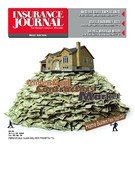Managing Editor, Insurance Insider
Computer programs designed to predict losses from possible cataclysmic events have been a boon to the insurance industry-the programs have reinforced reinsurers’ loss expectations, given rise to the insurance-linked securities market, and spawned an entirely new business.
But the catastrophe or “cat” models can contain biases that can under or overestimate loss events. Each third-party and proprietary model usually spews out different results given the same input. That’s why many insurance executives warn against using cat model results solely to price coverage.
“There is no substitute for an experienced underwriter,” said Anthony Taylor, CEO of Montpelier Re, at Standard & Poor’s recent insurance conference. “As 9/11 taught us, there are unforeseen events that can have an impact on the entire business.”
Without the involvement of an underwriter, industry observers say, an insurer’s capital is at the mercy of a computer that doesn’t take into account the myriad risks outside of its hard drive.
Cat models first emerged following 1992’s Hurricane Andrew. Reinsurers had commonly used “bank-payback” methods for underwriting. “Bank” is the difference between premiums and losses, net of the commission; “payback” is the expectation of reinsurer losses that would be recouped during the renewal period. Though it worked, bank-payback was highly volatile because it put little emphasis on the probabilities of loss events.
But after Andrew and its enormous, unexpected toll, new entrants into the reinsurance industry promised investors a scientific and stable method for calculating exposures through cat modeling. The models were borne out of the construction and engineering industries and included data about insured buildings that hadn’t been available to insurers.
The computer models generate different catastrophe scenarios-based on geographic and historical data-and then calculates the probability of insured events and potential losses. Three major third-party providers, Equecat, RMS and AIR, provide cat modeling, and many reinsurers create models in house.
Equecat started as a structural engineering firm, but branched out when clients asked for information regarding the risk in buildings the firm was working on, said Tom Larsen, Equecat senior vice president of product management.
Customers first asked questions about risks from a single event such as an earthquake, Larsen said. “Then the question became, ‘What would be the price if I wanted to transfer that risk?'”
About 80 percent of the reinsurance industry uses cat models in some capacity, according to Julie Serakos, senior vice president of Global Catastrophe Modeling Services for Willis Group.
“They use [cat models] to understand their underlying risk exposure, as well as the concentration of risk in particular regions,” she said. “And this is translated into pricing for certain product lines.”
Primary insurers are also beginning to use the modeling technique, Serakos said. “Any primary carriers and really larger insurance carriers are licensing models now. Especially when it comes to excess lines, or carriers with significant exposures to single states.”
But as so many carriers now use cat models, underwriters need to stay intimately involved in pricing decisions and in determining the probable maximum loss (PML), Serakos said. While established insurers almost always employ underwriters to price risk, new entrants in the market such as hedge funds are leaning heavily on models to price risk.
“Underwriters should always have a final say by providing meaningful insight into the risk exposures to different properties, and the framework to stay above PML,” she said. “[Cat models] shouldn’t be the only answer, and the companies that have gotten into trouble are the ones that focused only on their projections.”
For example, Steven Rutledge, CFO of Alpha Insurance Group in Alabama, said at the S&P conference that while his firm uses models to help determine hurricane exposures in the state, cat modeling has shortcomings.
“During Hurricane Ivan, we had a $325 million loss, and what we learned from that is that in Alabama, there are a lot of trees,” he said. “The model didn’t capture a lot of the tree damage.” He added the firm’s strong underwriting, especially for strong terms and conditions, helped mitigate losses.
Montpelier Re’s Taylor said that it’s important for carriers and reinsurers to understand the limits of cat models. His company uses commercial models based on geography and particular perils, while Montpelier’s in-house capital allocation model and underwriters are the final arbiters of price.
Equecat’s Larsen said his firm emphasizes to clients that they need the human underwriting touch in addition to modeling. “These are mental models, and they have biases,” he said “Where you use [cat models] you also need an experienced underwriter.”
“The goal of the models is to more accurately price risk, and not supplant the underwriting process,” Larsen said.
Willis’ Serakos adds that catastrophe models also need to be updated in a regular basis. “There is a push to put more real-time applications into the market,” she said. In terms of cat modeling, that means having information updated at least every 30 days.
“That is really the next step for these applications,” Serakos said.
Topics Catastrophe Carriers Profit Loss Underwriting Reinsurance
Was this article valuable?
Here are more articles you may enjoy.


 Good Times for US P/C Insurers May Not Last; Auto Challenges Ahead
Good Times for US P/C Insurers May Not Last; Auto Challenges Ahead  FBI Involved After Two Florida Injury Lawyers Go Missing From Fishing Trip
FBI Involved After Two Florida Injury Lawyers Go Missing From Fishing Trip  Cloudy Future for Bourbon Has Jim Beam Closing Distillery for a Year
Cloudy Future for Bourbon Has Jim Beam Closing Distillery for a Year  Disney Worker Injured Trying to Stop Runaway Boulder at Indiana Jones Show
Disney Worker Injured Trying to Stop Runaway Boulder at Indiana Jones Show 


